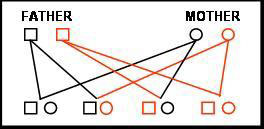BASIC PRINCIPLES

Each individual carries two copies or alleles of every gene: one on each chromosome. During the process of sexual reproduction, reproductive cells split by meiosis such that each sperm cell or ovum contains only one allele, on one chromosome. During fertilization, ovum and spermatozoon fuse, thus bringing together one allele from father and one from mother to provide a full complement.
The diagram shows how, with two possible alleles to inherit from mother and two from father, a child may inherit four possible combinations of alleles.
Patterns of Inheritance
Autosomal dominant forms of porphyria
These are:
- Variegate porphyria
- Acute intermittent porphyria
- Hereditary coproporphyria
Inheritance of a mutation on a single allele (inherited from either mother or from father) is sufficient for the disease to manifest. Such patients are heterozygous for the porphyria. Both sexes are equally affected, the disease does not skip generations and there is frequently a history of the porphyria in other family members.
Autosomal recessive forms of porphyria
These are:
- Congenital erythropoietic porphyria
- ALA dehydratase deficiency porphyria
The disease does not manifest unless both alleles carry mutations. Thus both mother and father must be carriers. The two mutations may be the same, in which case the patient is homozygous, or may be different, in which case the more correct term is double heterozygous. Both sexes are equally affected, but the disease frequently skips generations and there is often no family history.
Porphyria with complex inheritance
This applies to erythropoietic protoporphyria (EPP). Though EPP is basically an autosomal dominant disorder, there is evidence that the disease only presents clinically when a mutation on one allele is accompanied by a so-called "low-expression" allele on the other chromosome. This low-expression allele, though in itself resulting in disease, does not produce sufficient amounts of the normal enzyme to compensate for the mutant enzyme produced by the other allele. The consequence is that EPP often resembles an autosomal recessive disorder in its inheritance.
Acquired porphyria (sometimes with autosomal dominant inheritance)
Porphyria cutanea tarda (PCT)is usually an acquired disorder. We refer to this as sporadic PCT. Both alleles are normal and the disease is therefore not inherited. The disease is precipitated by an inhibition of the enzyme in response to factors such as alcohol and iron loading.
Approximately 20% of cases are however inherited. This is known as familial PCT, and is transmitted as an autosomal dominant trait. There is evidence that even in familial PCT, clinical disease usually only manifests where the enzyme produced by the normal allele is further inhibited by exposure to the same factors which may precipitate sporadic PCT ( such as alcohol and iron overload associated with sporadic PCT).
Variable Expression
Many patients who inherit a gene for porphyria will never express the disease clinically. Our own studies suggest that approximately 40% of patients who inherit the typical South African (R59W) mutation for variegate porphyria will show neither skin disease nor acute attacks. The proportion of asymptomatic patients with acute intermittent porphyria is even higher.
Homohygous Forms of Autosonal Dominant Porphyrias
Patients with the autosomal dominant form of porphyria require only a single mutated allele for disease to manifest. Very rarely, an individual is unfortunate enough to inherit two mutations (one each from father and mother). This typically results in a very severe form of the porphyria. In South Africa, we have identified four young VP patients with unusually severe symptoms who are double heterozygotes: they have the common South African R59W mutation on one allele (inherited from one parent), and another, uncommon mutation on the other allele (inherited from the other parent). These patients are described in Homozygous variegate porphyria.